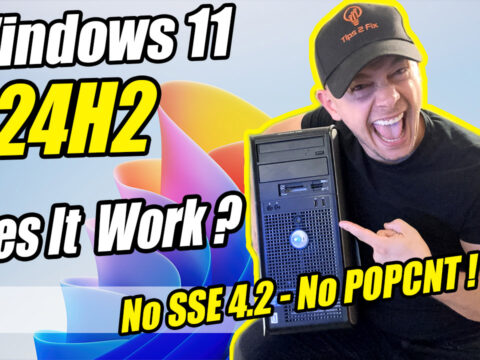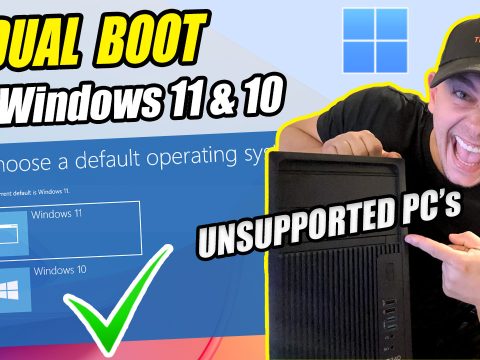If you’re running Windows 10 on an older PC and wondering whether you can install Windows 11 without the headache of command prompts or registry tweaks — you’re in the right place. In this complete guide, we’ll walk through the easiest updated method to install Windows 11 on unsupported hardware, using a beginner-friendly tool called FlyBy11.
Why Upgrade to Windows 11?
Windows 11 brings a sleek new design, improved security, faster performance, and better support for newer software and hardware. Microsoft is ending support for Windows 10 in October 2025, which means no more security updates. If your PC can handle it — even unofficially — this guide will help you upgrade smoothly.
PC Used in This Tutorial
- Intel Core i7-7700K (7th Gen – officially unsupported)
- 32GB RAM
- SSD storage (recommended for upgrade speed)
- Windows 10 Pro (latest version)
Even though this CPU is not on Microsoft’s supported list (Windows 11 requires Gen 8+), we’ll show how to bypass that limitation.
Step 1: Check If Your PC is Compatible
Download the PC Health Check Tool from Microsoft:
👉 https://www.microsoft.com/en-us/windows/windows-11#pchealthcheck
Use this tool to see if your PC passes the basic requirements. Most unsupported PCs will fail due to:
- CPU not on the list
- TPM 2.0 or Secure Boot not enabled
If you fail because of the CPU, don’t worry — we’ll bypass that!
Step 2: Download the FlyBy11 Tool
This script is CMD-free, meaning it has a simple user interface.
- Download from the developer’s official page : https://github.com/builtbybel/Flyby11
Download FlyBy11 - Extract the
.zipfile using built-in Windows extractor or 7-Zip - Inside the folder, right-click on
FlyBy11.exe→ Run as Administrator
If you get a Windows warning: click More Info > Run Anyway
Step 3: Check CPU for SSE4.2 and POPCNT
Before proceeding, make sure your CPU supports SSE4.2 and POPCNT instructions. These are critical for Windows 11 24H2 and 25H2.
✅ Supported:
- Intel CPUs Gen 3 and newer (2010+)
- AMD FX series and newer
If your CPU only supports SSE4.1 or lacks POPCNT, you cannot upgrade to Windows 11 24H2 or newer.
Step 4: Download the Windows 11 ISO from Microsoft
Go to the official Microsoft site:
👉 https://www.microsoft.com/en-us/software-download/windows11
- Scroll down to “Download Windows 11 Disk Image (ISO)”
- Select Windows 11 (multi-edition ISO)
- Choose your correct language:
en-USfor United Statesen-GBfor United Kingdomen(International) for other countries
To check your current language, run this in CMD:
DISM /Online /Get-Intl
Even if you don’t want to use CMD, you can copy and paste this line from my site.
Get Security Updates on Windows Updates Catalog:
https://www.catalog.update.microsoft.com/Home.aspx
Step 5: Start the Upgrade Process
Once you have the ISO file:
- Open FlyBy11
- Drag the ISO into the tool OR click “Select ISO”
- Wait for it to mount the ISO
- Keep the option “Download Drivers” enabled (recommended)
- Proceed with installation steps
If you don’t see the “Keep files and apps” option, it means your ISO language doesn’t match your current Windows language.
Step 6: Fix Common Installation Problems
If setup is stuck or fails:
- Unplug all USB devices (except keyboard and mouse)
- Disconnect cameras, external drives, hubs, etc.
- Delete temp files:
%temp%
If it still fails, try my other video tutorials linked below the video or blog.
💡 Fix Boot Issues: Enable AHCI Mode in BIOS
To fix this, make sure AHCI is enabled in your BIOS. Here’s how:
-
Restart your PC and enter BIOS (usually by pressing
DEL,F2, orF10when the system starts). -
Go to the Advanced, Storage, or SATA Configuration section (varies by motherboard).
-
Find the setting called SATA Mode or Storage Mode.
-
Change the value from IDE or RAID to AHCI.
-
Save and exit BIOS.
After enabling AHCI, your system should boot into Windows 11 without problems.
How to Convert MBR to GPT Using Command Prompt
Follow these steps:
-
Open Command Prompt as Administrator
PressStart, type cmd, right-click on Command Prompt and choose Run as administrator. -
Validate the Disk for Conversion
-
Convert the Disk to GPT
📝 What Happens Next?
Step 7: Verify the Upgrade
Once complete:
- Go to Settings > System > About
- You should see “Windows 11 Pro / 24H2”
- Windows will still show the CPU as unsupported, but updates will work.
You will get:
- Security updates
- Driver updates
- ❌ Major upgrades (like 25H2) won’t install via Windows Update — you’ll need to repeat this method.
Extra Notes
- Windows 11 only exists in 64-bit. You cannot upgrade from 32-bit Windows 10.
- Minimum RAM required: 4GB
- If your PC is too old (Core2Duo, etc.), don’t waste time — upgrade your hardware or use Windows 10 LTSC.
Help the Community
Vote on my poll: Which version works better for your PC: Windows 10 or 11?
Check the Community tab on my channel and help others decide.
Tips 2 Fix Poll
🎬 What’s Next?
- ✔️ How to Rollback to Windows 10 if You Don’t Like It
- ⚡ 15 Tricks to Speed Up Windows 11 on Old PCs
- Subscribe for future updates and fixes!
Thanks for reading — may God bless you, and see you in the next tutorial! 🙌







I could not upgrade my old Acer laptop, which has an Intel Core i5-7200U processor with SSE 4.2.
Error message: VirtualBox Uninstall this App because it isn’t compatible with Windows Server 2025. Manually uninstall require
AFTER INSTALLATION EVERY THINK IS GOOD BUT THE BATTERY DON’T SAVE POWER TO LONG MY BATTERY WAS SUPPORT 3H BUT NOW CAN’T SUPPORT 1H.
ANY SOLUTION??